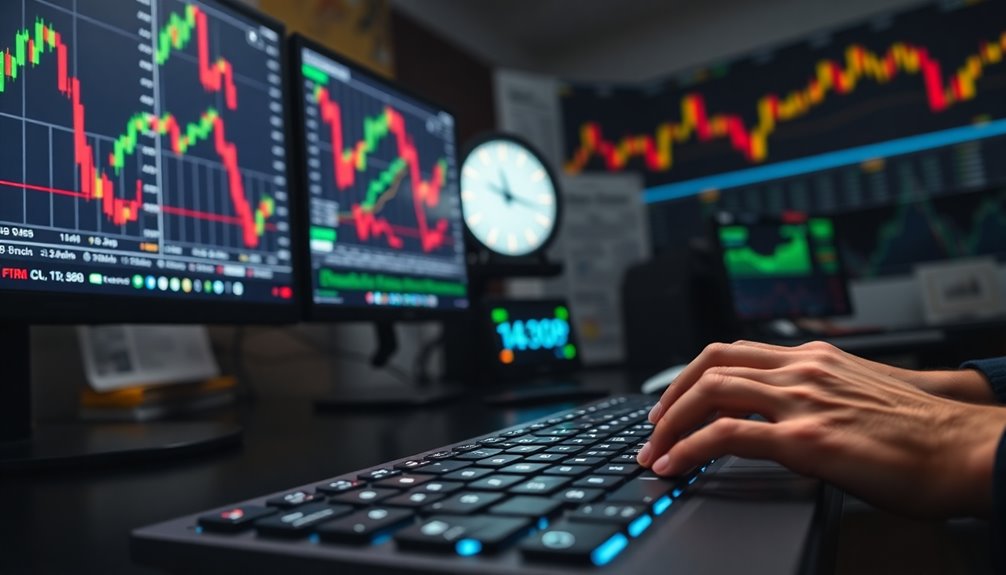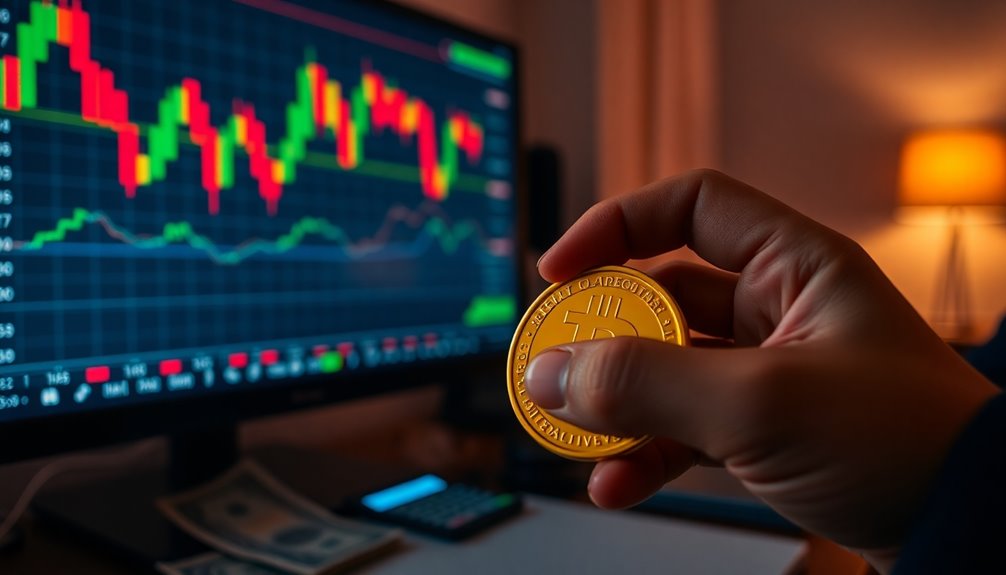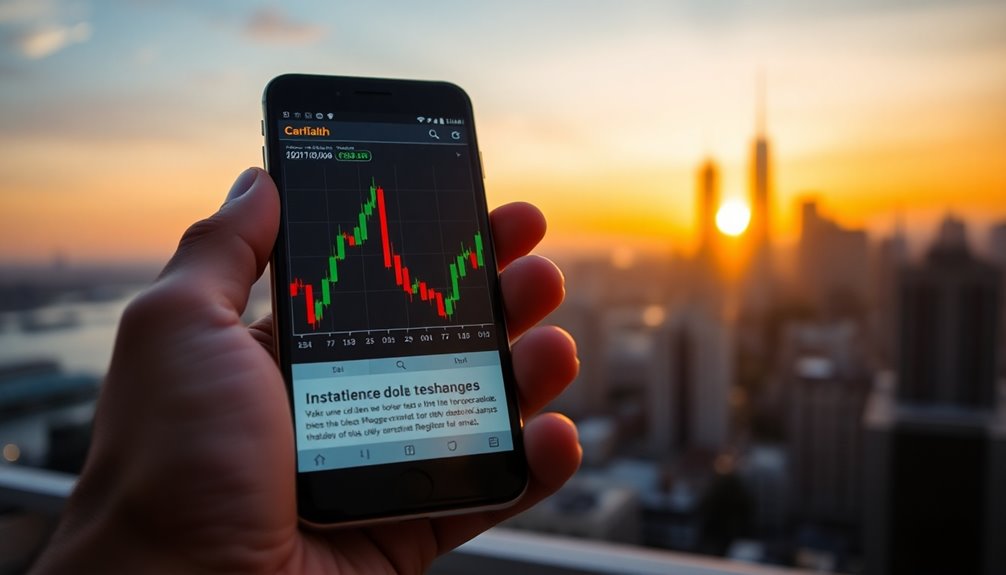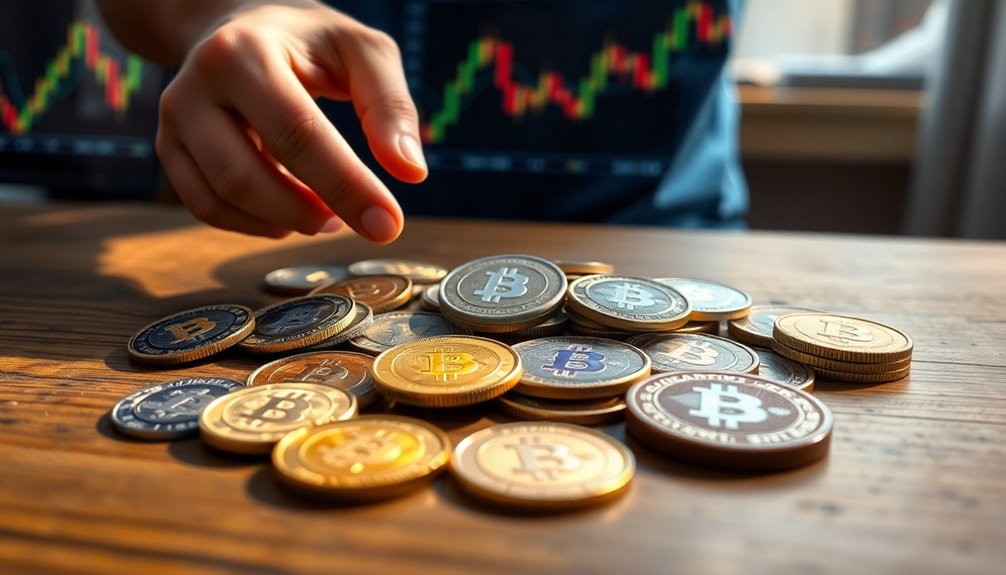Understanding volatility in the crypto market is essential for your investment journey. Prices can swing wildly due to factors like supply and demand, market sentiment, and regulatory changes. Volatility often stems from fear and greed, causing drastic price movements you need to be aware of. To manage risks, consider diversifying your portfolio by mixing stable cryptocurrencies with high-risk altcoins. Keep an eye on emerging trends and technologies that could influence your investments. By staying informed and adapting to market dynamics, you can better navigate these fluctuations and enhance your investment strategy moving forward. Additionally, understanding crypto market volatility allows you to recognize optimal entry and exit points for your trades. Implementing strategies such as setting stop-loss orders can help shield your investments from abrupt downturns. Ultimately, staying disciplined and embracing a long-term perspective will empower you to make more informed decisions amidst the chaos of cryptocurrency price fluctuations.
Key Takeaways
- Cryptocurrency prices are highly influenced by market sentiment, driven by emotions like fear and greed, leading to significant volatility.
- Supply and demand imbalances can cause drastic price changes, making it essential to stay informed about market trends.
- Regulatory changes can lead to sudden price fluctuations; understanding the regulatory landscape is crucial for managing investment risks.
- Diversification of your portfolio can mitigate risks associated with individual asset volatility, balancing stable and high-risk investments.
- Continuous monitoring of market developments and adjusting your investment strategy can help navigate the volatile crypto environment effectively.
Market Fluctuations Explained

Market fluctuations in the cryptocurrency world can often feel unpredictable, especially when driven by various external factors.
You'll notice that news plays a huge role; regulatory changes or significant partnerships can lead to rapid price shifts. Technological innovations also create waves, impacting market sentiment. Additionally, volatility factors such as rapid price fluctuations influenced by market psychology can create unexpected challenges for investors. New developments, like Bitcoin Runes, may also introduce fresh dynamics to the market landscape.
Don't underestimate market psychology either—fear and greed can send prices soaring or crashing. Media buzz can amplify speculation, influencing your investment decisions.
Lastly, supply and demand are crucial; an imbalance can lead to drastic price changes. Keep an eye on competing coins and limited supplies, as they can directly affect your assets' value.
Understanding these dynamics will help you navigate the unpredictable waters of cryptocurrency investment more effectively.
Crypto Market Overview

As you dive into the world of cryptocurrencies, it's essential to grasp the landscape's size and growth potential.
The crypto market, valued at $2.3 billion in 2023, is projected to reach $5.5 billion by 2033, with a compound annual growth rate of 7.5%. Key drivers include increasing adoption by individuals and institutions, the rise of decentralized finance (DeFi), and advancements in blockchain technology. Notably, the market is expected to see an increase in user base as it is projected to reach 992.50 million by 2028. Furthermore, the importance of effective digital asset management cannot be overstated as investors navigate this rapidly evolving space.
Volatility is a hallmark of this market, influenced by supply and demand dynamics, market sentiment, and liquidity issues.
As you explore, you'll notice various participants, from individual investors to institutions, all engaging in buying, selling, and holding digital assets, shaping a vibrant and evolving ecosystem.
Trading Mechanisms in Crypto

Understanding the trading mechanisms in crypto is vital for navigating this dynamic market. The order matching system pairs your buy and sell orders with counterparties, ensuring efficient trades and fair prices.
If you're looking to speculate without owning assets, CFD trading lets you do just that—though be cautious, as leverage can amplify both gains and losses. Your funds will be stored in a cryptocurrency wallet, which can be hot or cold, depending on your transaction needs. Additionally, cryptocurrency prices fluctuate based on supply, demand, and external news, making it essential to stay informed about market trends.
The trading engine processes trades in real-time, handling order execution and updating balances swiftly. This functionality is crucial, especially in volatile markets, ensuring all transactions are accurate and efficient.
Familiarizing yourself with these mechanisms will empower your trading journey.
Pros and Cons of Investing

Is investing in cryptocurrency worth the risk? On one hand, the potential for high returns is enticing. Cryptocurrencies can skyrocket in value, thanks to market volatility and growing adoption. Additionally, this market's unique nature can offer diversification benefits in investment portfolios, making it appealing for some investors. Furthermore, utilizing a Bitcoin IRA can provide tax-efficient growth for your retirement savings while incorporating cryptocurrency into your portfolio.
Plus, with the market operating 24/7, you can seize opportunities anytime. However, the risks are significant. Prices can fluctuate wildly, leading to steep losses, and cryptocurrencies lack hard asset backing.
Cybersecurity threats loom large, and unregulated exchanges expose you to scams. Additionally, the technical complexity and potential regulatory scrutiny can be daunting for newcomers.
You'll need to weigh these pros and cons carefully, as the rewards can be substantial, but so can the risks. Make informed decisions to navigate this unpredictable landscape.
Asset Class Performance Review

Investing in cryptocurrencies involves weighing significant risks against the potential for high rewards, but understanding how different asset classes perform can help inform your decisions. Bitcoin's volatility, while historically between 50% and 100%, has stabilized over time, offering opportunities for growth in a diversified portfolio. Its low correlation with traditional assets means it can act as a buffer against market fluctuations. Furthermore, it is crucial to never invest more than you can afford to lose, as this principle helps mitigate the impact of significant market fluctuations. Crypto whales often influence market trends, which can further affect Bitcoin's volatility.
Over the last decade, Bitcoin has outperformed many asset classes, making it a strong candidate for those seeking a store of value. However, remember to consider various valuation methods and their limitations. Balancing cryptocurrencies with traditional investments can enhance your portfolio's risk-adjusted returns, but be mindful of the potential downside risks involved.
Regulatory Uncertainty Impacts Investments

As regulatory bodies ramp up their scrutiny of cryptocurrencies, the uncertainty surrounding these regulations can significantly influence your investment decisions. Increased regulatory activity can lead to sudden price fluctuations, causing you to reconsider your strategies as you react to news and potential rule changes. Potential restrictions on crypto usage for financial services may further complicate your considerations.
Multiple regulators may overlap in authority, creating a convoluted compliance landscape that complicates your understanding of the market. Staying informed is crucial; it helps you navigate these risks and make more sound decisions.
Diversifying your portfolio across various digital assets can also mitigate risks associated with regulatory changes. While short-term volatility may challenge your confidence, remember that long-term prospects for cryptocurrencies like Ethereum remain strong due to their foundational roles in blockchain technology.
Emergence of Defi Protocols

While traditional finance often relies on intermediaries, the emergence of Decentralized Finance (DeFi) protocols is transforming how you can engage with financial services.
DeFi utilizes blockchain technology to enable peer-to-peer financing, eliminating the need for centralized institutions. With smart contracts, you can access a range of integrated financial instruments while maintaining control over your assets. This shift has led to a significant rise in value, attracting startups and venture capital interest.
The decentralized architecture ensures security, transparency, and permissionless access, allowing anyone with a crypto wallet and internet connection to participate.
Popular DeFi protocols like Maker, Compound, and Curve enhance governance and liquidity, making financial services more accessible and efficient.
Diversify Your Crypto Portfolio

With the rise of DeFi protocols, the landscape of investing has drastically changed, opening doors to new opportunities.
To succeed, you should diversify your crypto portfolio. Start by spreading investments across different cryptocurrencies based on their risk levels—combine stable assets like Bitcoin with high-risk altcoins for growth. This strategy can help reduce exposure to individual asset volatility and create a more resilient portfolio.
Don't forget sector diversification; invest in various sectors like DeFi, NFTs, and payment coins to capture emerging trends.
Also, consider market cap-based diversification: mix established coins with smaller, high-growth options.
Finally, allocate assets wisely; you might opt for a conservative, balanced, or aggressive strategy depending on your risk tolerance.
This approach not only mitigates risks but also positions you to seize potential gains in the ever-evolving crypto landscape.
Frequently Asked Questions
How Can I Protect My Investment During Market Downturns?
To protect your investment during market downturns, diversify your portfolio across various assets, including both cryptocurrencies and traditional investments like stocks.
Consider using dollar-cost averaging to consistently invest, reducing the impact of price fluctuations.
Implement stop-loss orders to minimize losses by automatically selling assets at a predetermined price.
Maintain a long-term perspective, focusing on fundamental values, and ensure your assets are secure with cold storage solutions.
Consistency is key!
What Tools Can Help Me Track Crypto Volatility?
To track crypto volatility effectively, you can use several tools.
The Crypto Volatility Index (CVI) dApp offers insights on 30-day implied volatility, while Evoura's ranking system provides real-time alerts for market movements.
Volmex Labs' indices measure the volatility of Bitcoin and Ethereum options.
Additionally, platforms like CoinStats and CoinMarketCap give you analytical features to monitor price fluctuations.
These resources help you stay informed and make better trading decisions.
Are There Specific Strategies for Volatile Markets?
In volatile markets, it feels like prices are dancing wildly on a rollercoaster!
You can harness this unpredictability by using strategies like disciplined stop-loss orders and dollar-cost averaging. Set clear thresholds to limit losses and invest a fixed amount regularly to lower your average entry price.
Consider grid trading to capitalize on price swings and always stick to a 1% risk per trade to manage your exposure effectively.
Consistency is key!
How Does News Impact Cryptocurrency Prices?
News significantly impacts cryptocurrency prices, shaping market sentiment.
When you hear positive news, like institutional adoption or favorable regulations, it boosts investor confidence, often driving prices up.
Conversely, negative news, such as regulatory crackdowns or security breaches, can trigger fear and lead to price drops.
You'll notice that major announcements can cause abrupt price swings, reflecting how sensitive the crypto market is to information.
Staying informed helps you navigate these fluctuations effectively.
What Psychological Factors Affect Crypto Investment Decisions?
Imagine you're at a high-stakes poker game, and every hand's a gamble.
When it comes to crypto investments, factors like risk tolerance and overconfidence play pivotal roles. If you've got high risk tolerance, you might chase those big returns, but overconfidence could blind you to lurking dangers.
Plus, the fear of missing out (FOMO) can push you into hasty decisions, impacting your overall investment strategy.
Stay aware of these psychological influences!
Conclusion
In the wild world of crypto, understanding volatility is your best weapon. The market's ups and downs can feel like a rollercoaster ride, but with the right knowledge, you can navigate it like a pro. By diversifying your portfolio and staying informed about trends and regulations, you'll position yourself for success. Remember, every investment carries risks, but with patience and a smart strategy, you can ride the waves of this digital frontier and watch your efforts soar!









